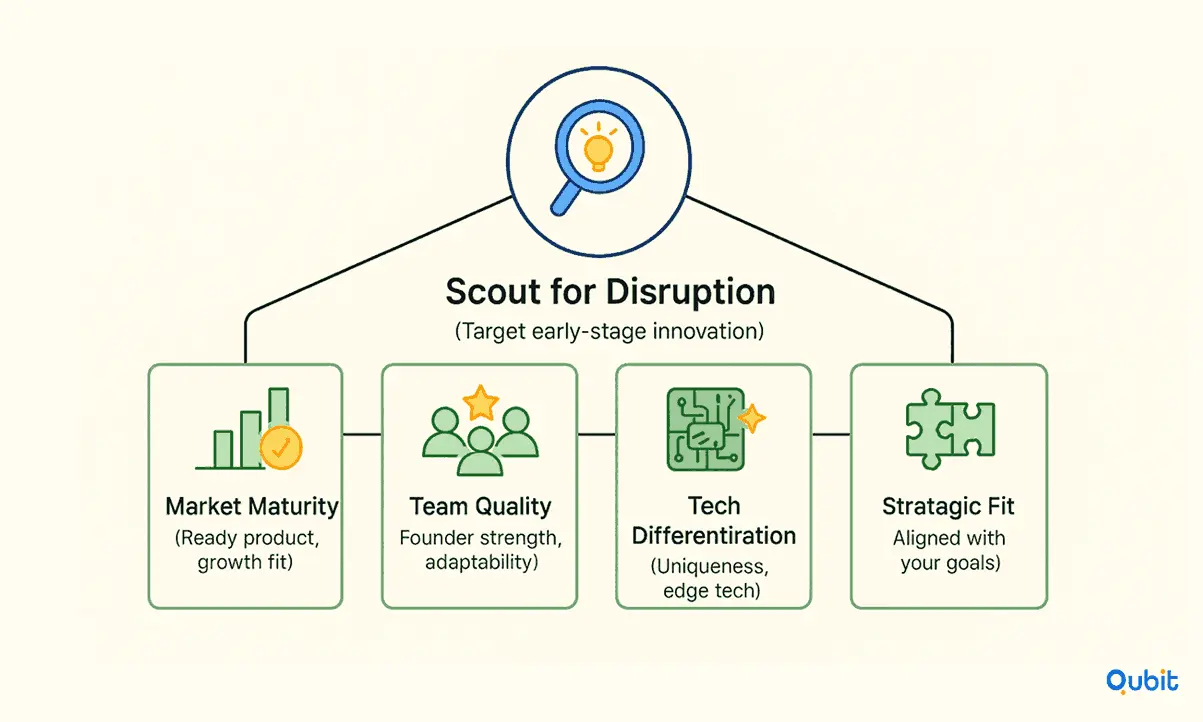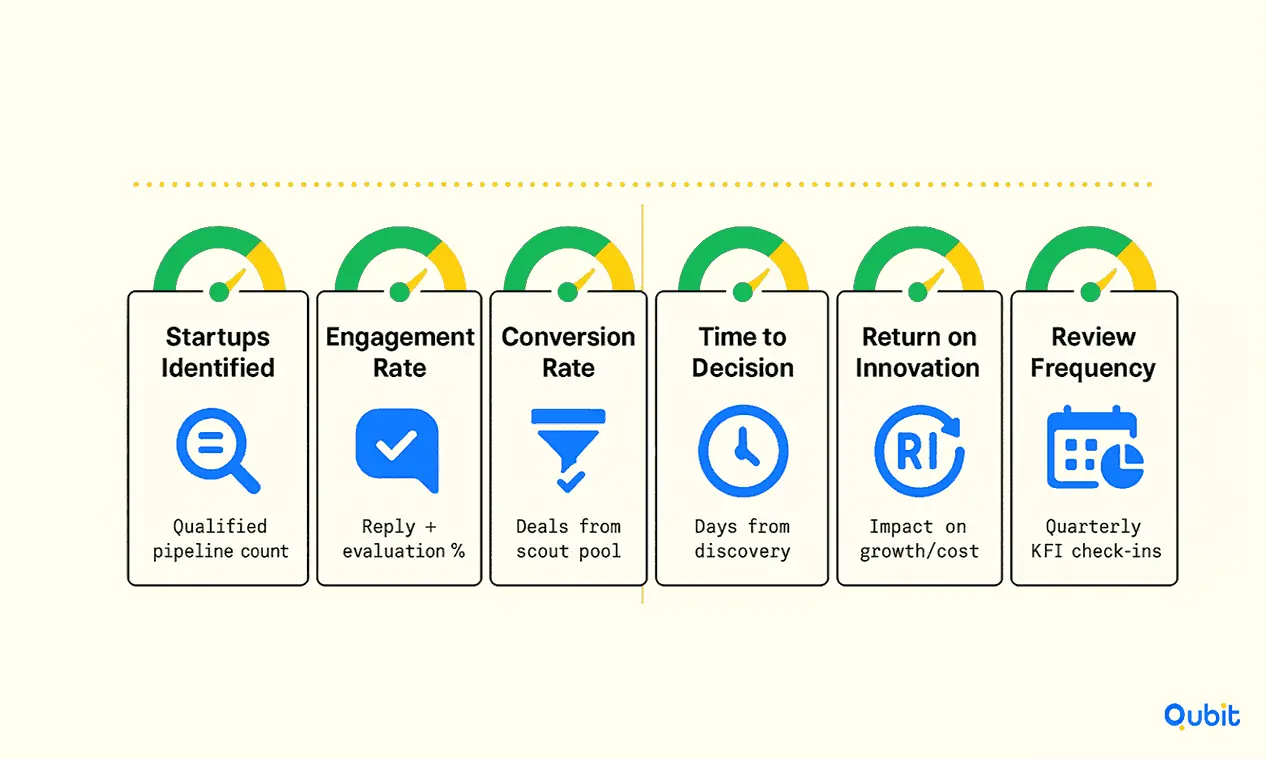Startup scouting is the cornerstone of identifying innovative opportunities in a rapidly evolving business ecosystem. It involves systematically uncovering promising startups that align with strategic goals, whether for investment, partnership, or acquisition. By focusing on structured criteria and actionable frameworks, startup scouting enables decision-makers to sift through the noise and pinpoint ventures with the highest potential.
Your exploration of startup scouting fundamentals naturally connects to the broader perspective offered by the startup scouting strategies discussion, which provides an overarching view of early-stage investment frameworks.
This introduction sets the stage for understanding how continuous monitoring, data-driven insights, and clear evaluation criteria can transform your approach to startup scouting. Let’s jump right in.
Understanding Startup Scouting
Startup scouting is a strategic process that enables organizations to identify, evaluate, and engage with early-stage companies that exhibit disruptive potential. Unlike general technology scouting, which focuses on a broader spectrum of innovations, startup scouting zeroes in on emerging businesses that offer unique solutions, cutting-edge technologies, or innovative business models.
The growing importance of startup collaborations in corporate innovation strategies cannot be overstated. According to recent data, 88% of corporate participants consider collaboration with startups critical to their innovation strategies. This statistic underscores the necessity for businesses to actively engage with startups to remain competitive and forward-thinking.

Key Elements of Startup Scouting
To effectively scout startups, organizations must focus on several critical elements:
Market Maturity
Assessing the market readiness of a startup is crucial. This involves evaluating whether the startup’s product or service aligns with current market demands and has the potential for scalability.Team Quality
A startup’s success often hinges on the strength of its team. Factors such as the founders’ expertise, leadership skills, and adaptability play a significant role in determining the startup’s long-term viability.Technological Differentiation
Startups that offer unique, innovative technologies stand out in a crowded market. Evaluating the technological edge of a startup ensures that it brings something truly novel to the table.Strategic Alignment
Finally, the startup’s goals and solutions must align with the strategic objectives of the scouting organization. This alignment ensures that the partnership delivers mutual value and fosters sustainable growth.
By focusing on these elements, organizations can streamline their scouting efforts and maximize the impact of their collaborations with startups.
The Value of Startup Scouting: Accelerating Innovation
Startup scouting has emerged as a transformative strategy for organizations aiming to stay ahead in competitive markets. By identifying and collaborating with innovative startups, companies can access fresh ideas, cutting-edge technologies, and agile execution models that drive corporate innovation. This approach not only accelerates product development but also helps businesses bypass internal bottlenecks that often hinder progress.
Why Startup Scouting Matters
Startup scouting enables organizations to tap into external innovation ecosystems, fostering partnerships that bring new perspectives and solutions. Industry experts advocate sourcing at least half of new ideas from external innovations, emphasizing the importance of integrating startup-driven insights into corporate strategies.
Moreover, scouting startups allows businesses to align with emerging trends and high-growth sectors. A review of high-growth startup sectors 2026 presents specific market trends that integrate well with the strategic insights detailed in this foundational guide. This alignment ensures that companies are not only innovating but doing so in areas with significant market potential.
Benefits of External Partnerships
Collaborating with startups offers several advantages:
Rapid Execution: Startups are known for their agility, enabling faster development cycles and quicker market entry.
Cost Efficiency: External innovation often reduces the financial burden associated with in-house R&D.
Access to Expertise: Startups bring specialized knowledge and unique skill sets that complement corporate capabilities.
These partnerships also foster a culture of innovation within organizations, encouraging teams to think creatively and adopt new methodologies.
The Strategic Edge
For businesses aiming to thrive in dynamic markets, startup scouting is not just a tactic, it’s a strategic imperative. It bridges the gap between corporate innovation goals and the practical execution of groundbreaking ideas. As industries evolve, the ability to scout and integrate external innovations will define the leaders of tomorrow.
Challenges in Startup Scouting
Startup scouting, while essential, comes with a distinct set of challenges that can hinder effectiveness if not addressed properly. Common obstacles include:
- Data Overload: With thousands of startups emerging globally, scouts face an overwhelming volume of information. Sifting through noise to identify relevant ventures demands effective filtering tools and prioritization criteria.
- Incomplete or Inconsistent Profiles: Early-stage startups may provide limited or unverified information, complicating assessment and increasing the risk of missed opportunities or poor fits.
- Resource Constraints: Building and maintaining a robust scouting function requires skilled personnel and dedicated time, which can be scarce in fast-moving corporate environments.
- Bias and Subjectivity: Without structured evaluation frameworks, unconscious biases can influence startup selection, leading to inconsistent or suboptimal decisions.
Harnessing Technology: Scouting Software Benefits
The Growing Demand for Technology Scouting Software
The adoption of technology scouting platforms is accelerating, driven by the need for efficient discovery and evaluation of emerging innovations. The Technology Scouting Software Market is forecasted to expand at an impressive 17.6% CAGR, growing from USD 150.17 million in 2023 to USD 646.17 million by 2032. This growth trajectory highlights the increasing reliance on these tools to streamline processes and enhance decision-making.
Key Benefits of Technology Scouting Software
Technology scouting software offers a range of advantages that transform how businesses identify and assess opportunities.
1. Centralized Data Management
One of the standout features of these platforms is their ability to consolidate information from multiple sources into a single, accessible database. This eliminates the inefficiencies of scattered data and ensures that teams can access relevant insights quickly.
2. Automated Due Diligence
Manual processes often slow down the evaluation of startups and technologies. Scouting software automates due diligence tasks, such as background checks and performance analysis, saving time and reducing human error.
3. Customizable Scoring Systems
Advanced platforms like Q-scout allow users to tailor scoring criteria to match their specific investment thesis. This ensures that evaluations align closely with strategic goals, making it easier to identify high-potential opportunities. For example, investment thesis startup scouting aligns seamlessly with these systematic frameworks, offering practical ways to match criteria with emerging opportunities.
Why Businesses Are Turning to Scouting Software
The projected market growth underscores the increasing adoption of technology scouting tools. As industries become more competitive, organizations are seeking solutions that reduce manual overhead and enhance the accuracy of their evaluations. Platforms like Q-scout exemplify this shift, offering features that streamline discovery and improve decision-making efficiency.
By integrating technology scouting software into their workflows, businesses can stay ahead of trends, identify promising startups, and make data-driven decisions that align with their strategic objectives.
Startup Scouting Strategies & Best Practices for Success
Identifying and collaborating with innovative startups can be a transformative process for organizations aiming to stay ahead in competitive markets. A well-structured startup scouting program not only uncovers groundbreaking solutions but also fosters long-term partnerships that drive mutual growth. This section explores actionable strategies and best practices to optimize your startup scouting efforts.
1. Build a Scalable Scouting Framework
A scalable framework ensures that your scouting process can adapt to the evolving needs of your organization. For instance, GELITA AG successfully implemented the HYPE Partnering platform, which integrates AI-powered analytics to streamline their scouting efforts. This approach enabled them to evaluate 31 startup applications, with six advancing to the final evaluation stage and two progressing to pilot partnerships. Their success highlights how a structured program can scale globally and yield robust results.
2. Harness AI and Big Data for Precision
The integration of AI and big data analytics has revolutionized startup scouting. These technologies automate the discovery, evaluation, and monitoring of startups, providing real-time insights that help corporate innovation teams make informed decisions. By leveraging advanced analytics, organizations can expand their global reach efficiently while maintaining precision in their scouting efforts.
3. Avoid Common Pitfalls
Even the most well-intentioned scouting programs can falter without careful planning. An analysis of startup scouting mistakes reveals commonly observed oversights, such as neglecting to define clear objectives or failing to engage with the startup ecosystem consistently. Addressing these pitfalls early on can significantly enhance the effectiveness of your scouting strategy.
4. Engage Continuously with the Ecosystem
Startup ecosystems are dynamic, requiring consistent engagement to stay updated on emerging trends and opportunities. Attend global networking events, collaborate with incubators and accelerators, and maintain active participation in industry forums. These efforts not only expand your network but also position your organization as a credible partner for startups.
5. Iterate and Refine Your Approach
Startup scouting is not a one-size-fits-all process. Regularly evaluate the effectiveness of your strategies and refine them based on feedback and outcomes. This iterative approach ensures that your program remains aligned with your organization’s goals and the evolving startup landscape.
Metrics and KPIs for Scouting Success
Measuring success in startup scouting ensures continuous improvement and alignment with strategic goals. Key performance indicators (KPIs) to monitor may include:

- Number of Startups Identified: Tracking the size and quality of the initial pipeline.
- Engagement Rate: The percentage of startups responding or advancing to deeper evaluation stages.
- Conversion Rate: Proportion of startups moving from scouting to partnership, investment, or acquisition.
- Time to Decision: Average duration from discovery to final decision, reflecting scouting efficiency.
- Return on Innovation: Quantifiable impact of sourced startups on revenue growth, market expansion, or cost reduction.
Regularly reviewing these KPIs helps refine scouting strategies, allocate resources effectively, and demonstrate scouting’s value to leadership.
Funding and Investment Decision Integration
Startup scouting must interface smoothly with funding and investment processes to convert insights into concrete actions. Key integration points include:
- Alignment with Investment Thesis: Scouting efforts should reflect the organization’s focus areas, risk tolerance, and expected returns.
- Structured Handoffs: Clearly defined workflows and communication channels between scouts and investment committees accelerate evaluation and deal execution.
- Collaborative Decision-Making: Involve cross-functional stakeholders early to assess startups’ strategic fit alongside financial viability.
- Post-Investment Tracking: Ensure feedback loops exist to evaluate startup performance and refine scouting priorities accordingly.
This integration ensures that scouting drives meaningful investments and partnerships aligned with long-term objectives.
Market and Competitive Analysis in Startup Scouting
Incorporating market research and competitive intelligence enhances startup scouting effectiveness by:
- Identifying Opportunity Gaps: Understanding market trends and competitor moves reveals niches ripe for innovation.
- Evaluating Startup Fit: Contextualizing startups within current competitive landscapes informs strategic relevance.
- Anticipating Risks: Monitoring emerging threats and disruptors supports risk-aware scouting decisions.
- Informing Strategic Priorities: Aligning scouting with where the market is headed maximizes impact and value creation.
Integrating these analyses into scouting workflows strengthens decision quality and strategic alignment.
Conclusion
Adopting a structured approach to startup scouting can transform the way businesses identify and capitalize on emerging opportunities. By focusing on clarity in evaluation criteria, integrating advanced technologies, and utilizing systematic frameworks, organizations can streamline their processes and make more informed decisions. Additionally, fostering external collaborations and committing to continuous improvement ensures that the scouting process remains dynamic and effective.
These strategies not only enhance the ability to discover innovative startups but also position businesses for sustained competitive advantage. If you're ready to elevate your startup scouting strategy, we at Qubit Capital are here to help. Explore our Investor Outreach service today and connect with potential investors who can drive your vision forward.
Key Takeaways
- Startup scouting is essential for discovering disruptive early-stage ventures and driving corporate innovation.
- A structured framework, with clear criteria and continuous evaluation, streamlines the scouting process.
- Integrating advanced technology scouting software enhances data centralization and decision-making.
- Collaborative approaches, rather than competitive mindsets, foster stronger innovation ecosystems.
- Real-world case studies, like that of GELITA AG, validate the effectiveness of these systematic strategie
Frequently asked Questions
What is startup scouting?
Startup scouting is the process of identifying, evaluating, and engaging early-stage companies that offer disruptive innovations. It involves systematic research, market fit assessments, and structured due diligence.






